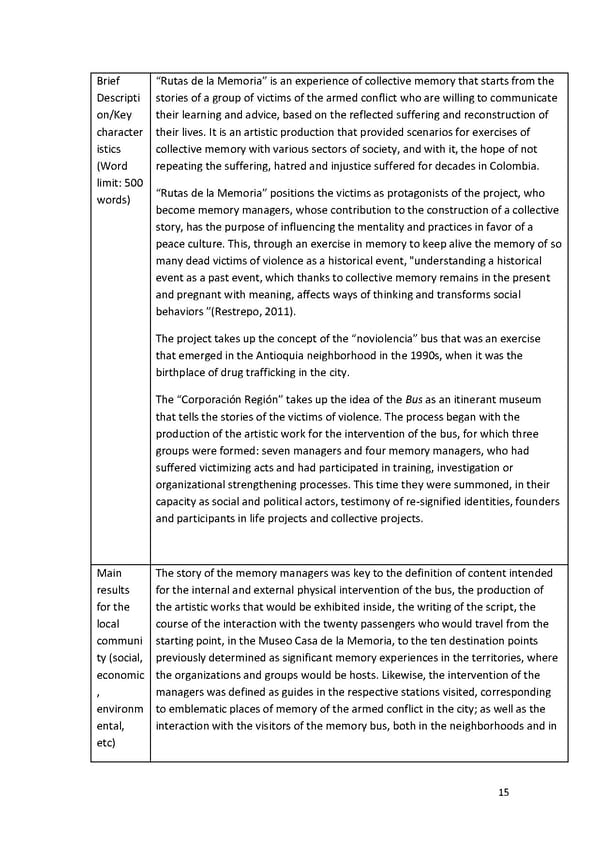Brief “Rutas de la Memoria” is an experience of collective memory that starts from the Descripti stories of a group of victims of the armed conflict who are willing to communicate on/Key their learning and advice, based on the reflected suffering and reconstruction of character their lives. It is an artistic production that provided scenarios for exercises of istics collective memory with various sectors of society, and with it, the hope of not (Word repeating the suffering, hatred and injustice suffered for decades in Colombia. limit: 500 words) “Rutas de la Memoria” positions the victims as protagonists of the project, who become memory managers, whose contribution to the construction of a collective story, has the purpose of influencing the mentality and practices in favor of a peace culture. This, through an exercise in memory to keep alive the memory of so many dead victims of violence as a historical event, "understanding a historical event as a past event, which thanks to collective memory remains in the present and pregnant with meaning, affects ways of thinking and transforms social behaviors ”(Restrepo, 2011). The project takes up the concept of the “noviolencia” bus that was an exercise that emerged in the Antioquia neighborhood in the 1990s, when it was the birthplace of drug trafficking in the city. The “Corporación Región” takes up the idea of the Bus as an itinerant museum that tells the stories of the victims of violence. The process began with the production of the artistic work for the intervention of the bus, for which three groups were formed: seven managers and four memory managers, who had suffered victimizing acts and had participated in training, investigation or organizational strengthening processes. This time they were summoned, in their capacity as social and political actors, testimony of re-signified identities, founders and participants in life projects and collective projects. Main The story of the memory managers was key to the definition of content intended results for the internal and external physical intervention of the bus, the production of for the the artistic works that would be exhibited inside, the writing of the script, the local course of the interaction with the twenty passengers who would travel from the communi starting point, in the Museo Casa de la Memoria, to the ten destination points ty (social, previously determined as significant memory experiences in the territories, where economic the organizations and groups would be hosts. Likewise, the intervention of the , managers was defined as guides in the respective stations visited, corresponding environm to emblematic places of memory of the armed conflict in the city; as well as the ental, interaction with the visitors of the memory bus, both in the neighborhoods and in etc) 15
 Memory Best Practices 1 Page 14 Page 16
Memory Best Practices 1 Page 14 Page 16